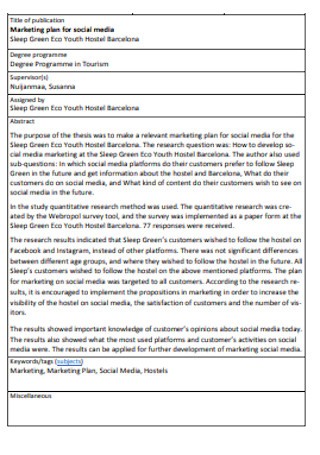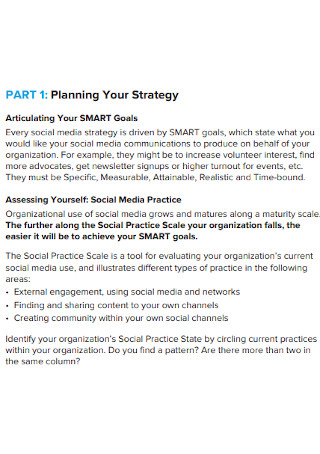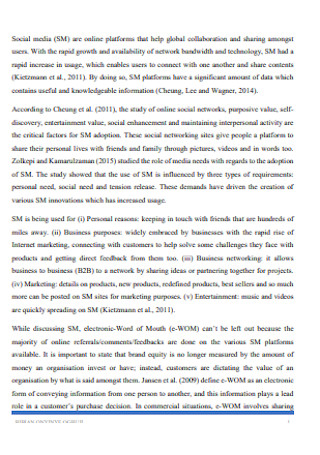50+ Sample Social Media Strategic Plans
-

Sample Social Media Strategic Plan
download now -

Social Media Strategy Tactical Plan
download now -

Social Media Strategy Plan Format
download now -

Social Media Strategy Development Plan
download now -

Marketing Plan for Social Media
download now -

Social Media Strategy Workbook Plan
download now -

Company Media Strategy Plan
download now -

Social Media Strategy Planning Example
download now -

Social Media Strategy Wheel Plan
download now -

Social Footprint Strategy Plan
download now -

Social Media Strategy Museums Plan
download now -

Investigating Social Media Strategy Plan
download now -

Social Media Marketing Plan
download now -

Digital and Social Media Marketing Plan
download now -

Social Media Strategy Plan for HR
download now -

University of Social Media Strategy Plan
download now -

Simple Social Media Strategy Plan
download now -

Social Media Project Strategy Plan
download now -

Social Media Strategy Plan for Under Armour
download now
FREE Social Media Strategic Plan s to Download
50+ Sample Social Media Strategic Plans
What Is a Social Media Strategy Plan?
Different Types of Social Media Strategies
How to Create a Social Media Strategy Plan
Different Types of Social Media Platform
FAQs
What are the usual Key Performance Indicators or key metrics in social media marketing?
What are social media managers?
How many posts should be planned for each social media platform?
What are different types of social media content?
What Is a Social Media Strategy Plan?
Over the years, local small shops and e-commerce businesses have been harnessing the power of social media to reach their audiences and helped them succeed. In fact, 97% of Fortune 500 companies have social media accounts to connect with audiences and for extended customer service. Social media strategic plans refer to the marketing strategies done online by companies. This means that businesses leverage the power of social media not only to promote their brands but also to establish connections with their target audience.
To sum it up, it’s like a social media business plan that details everything that has to be done and accomplished using different social media platforms for your business. It is a guide on what you have to do to gain traction for your brand and gauge whether you are hitting your targets or not.
Different Types of Social Media Strategies
Every organization has different objectives and goals towards its business continuity plan. That is because there are varying factors in every business as well from the business size, type of organization, etc. But generally, a standard BCP would cover the following elements:
How to Create a Social Media Strategy Plan
Whether you’re just starting with social media or it’s your first time creating a social media strategy, it never hurts to plan and get your leg up on the competition. And the best way to do just that is to create a solid and smart social media marketing plan for your business that will actively engage the audience. Read on below to learn how to create a social media strategy plan and social media campaign strategy.
Step 1: Set Social Media Marketing Goals That Align with Business Objectives
Your social media marketing goals will answer the question of why you want to have a social media presence. Think about where you want your brand to go when you’re on social media.
Do you want to increase your brand awareness and make it last? Or building a huge social media following and a community is what you want? Is it to drive more revenue from your social media accounts?
Your social media strategy plan starts with your goals in mind. This will define your social media content plan as well as your media plan strategy. This will also dictate how much time and money will be spent on your social media campaign plan.
Step 2: Learn About the Target Audience
In the current social media marketing is a dynamic landscape and making assumptions about your audience is a huge no-no! If you’re starting and don’t know where to go, there are a wide variety of social media analytics tools that you can lean on.
Granted that you know where to look, what you need to know about your target audience is readily available. With this knowledge, you can easily craft a media plan strategy that will influence your audience and attract the right demographics. You can use this information to determine which platforms are being used by your target audience and the type of content that you need to publish.
Step 3: Select Platforms Where Your Audience Are
It’s basic knowledge for every social media marketing that different platforms attract different audiences and require different content. As a social media strategist and marketer, you should do your homework about the existing social media platforms and gain insights into various channels.
An old social media strategy to help you select your platforms and establish your key metrics is through social media listening. This means listening and auditing both audience and competition to determine where and how you should be active on social media. Knowing where your audience holds digital conversations can help you interact with them faster and easier.
Step 4: Design, Create, and Curate Engaging Social Media Original Content
Figure out which type of content appeals to your audience. Observe your competitors’ social engagement and watch out for content that works for them. But this doesn’t mean that you copy their strategies. You should know that what works for them may not work for you that’s why you also need to create your own type of content that’s really about you. This means figuring out what gets your audience to engage with your content.
So, carefully plan social media posts. Design, create, and curate content that appeals to your audience. Do they engage more with videos or images? How do you convey your message to them? Which voice and tone do they engage with more? What type of messaging should you send and how should you present them–questions? Jokes? Slogans? Or is it motivational quotes?
Step 5: Amplify Distribution and Make Your Social Media Presence Felt
You’ve set up everything and may already be preparing for execution. Now, how can you maximize the distribution of your social media content and ensure that you can have a wide reach? For beginners and few followings, a paid promotion is one option to take. Major social media networks offer advanced targeting that can help you circle in on your audience.
With the paid promotion, these social media platforms will strategically place your posts and show them to your targeted audience in exchange for payment. This will ensure that you are reaching the right audience and potential customers.
Step 4: Execute, Assess, and Tweak Strategy Where Needed
Sharing great content is essential and reaching the right audience is also important. That’s why you need to have a plan for when you will share your content for maximum exposure and optimal reach. A social media calendar can help you get organized with your content and monitor each campaign strategically. Depending on your social media goals, your posts can be divided into several categories and determine the right content mix. You can set your posting schedule ahead of time and space out posts appropriately and at peak times.
Track your results and determine which posts and strategies are working best for you and which ones are not and need to be improved or revised. Use the data of your running campaigns to evaluate the effectiveness of your strategies and understand what works and what doesn’t so you can refine your strategies in the future.
Different Types of Social Media Platform
There are different types of social media platforms that managers or marketers use to execute their media marketing plan, specifically that of online marketing. Here are some of the types of social media and what they are being used for:
- Social networking sites where users connect with people they know or interact with celebrities and influencers, as well as brands online. Facebook, Twitter, and LinkedIn are some of a few examples of this type of platform.
- Media sharing networks are used to share photos, videos, and other media online. An example of this is Youtube and Instagram.
- Discussion Forums like Reddit and Quora are examples of discussion forum sites that allow users to post, share news, ideas, and opinions about a topic, and discuss them with other users.
- Bookmarking and content curation networks are social media sites that let users discover, save, and share new content. Pinterest, Imgur, Flipboard are examples of these sites.
- Interest-based networks are sites that connect people with others around shared interests and hobbies. An example of which is Goodreads, a website that connects book-lovers.
- Social shopping networks help their users spot new trends, follow brands, share great finds, and directly purchase products. Etsy and Amazon are examples of these types of networks.
Knowing and understanding the different types of social media platforms can help you come up with new ideas that will effectively engage with your audience.
FAQs
What are the usual Key Performance Indicators or key metrics in social media marketing?
Other than gaining followers, the most common indicators that your social media strategies are working are conversion rates, time spent on websites, reach, brand mentions, shares, engagement.
What are social media managers?
Social media managers are marketers on social media that help grow and manage online communities. Their tasks usually include writing and scheduling posts, running ads, interacting with followers and replying to comments, and creating graphics.
How many posts should be planned for each social media platform?
The answer depends on your ability to produce quality and valuable content. As a beginner, two to three posts per week should suffice. For accounts with a large staff and larger following, they post at least once a day. Make sure to allocate time to respond to private messages and comments.
What are different types of social media content?
There is a lot of social media content that businesses and brands use to their advantage. The most common types of content are:
- Written posts such as blogs, articles, guides, etc.
- Videos and Images
- Video Stories and Live Videos
- Infographics
- Testimonials and reviews
- Contests and Announcements
Developing your social media strategy plan is not as easy as creating an account on Facebook or Youtube. It is probably one of the most difficult to do and requires you to look at the bigger picture to create an effective social media plan. It goes beyond daily tasks such as post scheduling and replying to comments–it requires a higher level of thinking and anticipating customer needs.
